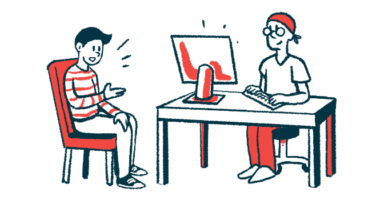Virtual Avatar Improved Attention and Memory

SFIO CRACHO/Shutterstock
Using a virtual avatar to guide users during attention and memory tasks significantly improves the performance of people with Rett syndrome, according to a small study from Italy.
The human-like interactive agent likely acts as a social motivator for these patients, who often focus on the face of parents and therapists, the researchers noted.
These early findings are consistent with previous data showing the presence of virtual avatars within a learning environment increases attention and learning abilities in children with attention deficit hyperactivity disorder (ADHD) and other disabilities.
They suggest that virtual avatars may help Rett patients improve their attention and memory, and possibly overall performance in everyday activities. Still, larger studies are needed to confirm the value of using a virtual avatar in the learning process, the researchers noted.
The study, “The role of a virtual avatar in attention and memory tasks in Rett syndrome,” was published in the journal BMC Neurology.
Rett syndrome results in motor, language, cognitive, and behavioral disturbances, among other problems. Due to severe motor and speech impairments, people with Rett syndrome frequently use their eyes to communicate.
As such, eye-tracking technologies have gained increasing interest as potential means to better assess cognitive performance in this patient population.
Previous studies have suggested that interaction with virtual objects and events, including avatars, can improve attention and learning in patients with intellectual disabilities and ADHD.
The presence of a computerized pedagogical (teaching) agent within a learning environment is hypothesized to act as social motivator, boosting the user’s interest in the task, similar to the influence of a real person.
Notably, since Rett patients “are very motivated to look at the face of therapists and parents, an avatar acting human-like gestures, speech, gaze and behaviors may be very motivating to join in the learning process,” the researchers wrote.
However, the potential value of using virtual avatars in people with Rett syndrome remains unknown.
Now, a team of researchers in Italy assessed whether the use of a virtual avatar can improve attention and memory skills in 35 females and one male with Rett syndrome.
Patients’ ages ranged from 4 to 36 years, and most attended schools or socio-educational centers (88.9%) and had moderate disease severity (77.1%), as determined with the Rett Assessment Rating Scale.
All participants underwent a total of four memory tasks and two attention tasks, which were presented randomly on a screen with and without the virtual avatar, during the 2019 Rett summer campus of the Italian Association for Rett syndrome.
The avatar, created through an educational platform, gave the instructions of the task and asked the patients to give the answer. In the avatar’s absence, a voice provided instructions and solicited the replies.
The tasks were monitored and completed through eye-tracking technology.
Results showed that the presence of the virtual avatar significantly extended the time spent looking at the correct stimulus and also significantly increased the number of correct answers in both tasks, when compared with tasks completed without the avatar.
Notably, Rett patients “presented a statistically significant improvement in attention and memory abilities” when performing the tasks with the avatar, the researchers wrote.
The team also found a significant association between higher levels of disease severity and poorer performance in the attention and memory tasks.
These findings indicate that “the avatar acts as a cognitive strengthener” in Rett patients, helping them “structure the appropriate processes and improve their attention and their learning,” the team wrote.
This information may help “families and educators to identify what software can be effectively used to help children and girls with RTT [Rett syndrome], and also software designers to make good evidence-based choices to offer more focused software, capable of giving significant performance improvements,” the researchers added.
The team noted, however, that more studies are needed to confirm these findings and to better understand the conditions under which an avatar can improve the learning process of Rett patients.
It also would be interesting to verify “whether the avatar can also act as a social motivational model and improve attention and memory at neurological level” by measuring patients’ brain activity during the tasks, the team concluded.







